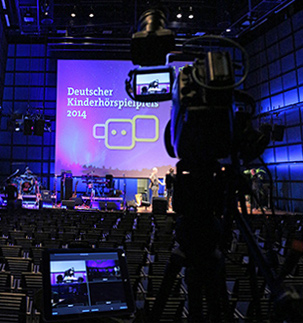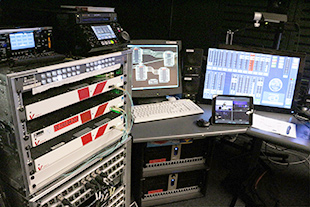Attracting more than 9,000 visitors, the Radio Days event held by German public broadcasters’ association ARD provided a further demonstration of the benefits of technical advances in production.
 Held at the Center for Art and Media Technologies (ZKM) in Karlsruhe, the event included live radio dramas and interviews, alongside the presentation ceremony for the German Radio Drama Award (Deutscher Hörspielpreis). In addition to being aired on radio, these were broadcast via live audio and video streams on the internet, and also recorded for later download. The quality standards that the public broadcasters set themselves for streaming productions like this are close to those of their regular productions – but the budgets for their production are lower.
Held at the Center for Art and Media Technologies (ZKM) in Karlsruhe, the event included live radio dramas and interviews, alongside the presentation ceremony for the German Radio Drama Award (Deutscher Hörspielpreis). In addition to being aired on radio, these were broadcast via live audio and video streams on the internet, and also recorded for later download. The quality standards that the public broadcasters set themselves for streaming productions like this are close to those of their regular productions – but the budgets for their production are lower.
The events comprising Radio Days took place in different venues within the ZKM facilities with four cameras in use. Their feeds were sent to a control room, together with audio and communications signals. Here Sascha Schwoll and Wolfgang Goetz (both from broadcasters within ARD) devised a method to achieve this efficiently and flexibly, with the highest possible production standard. Central to their approach were several Lawo V__link 4 Video-over-IP processors and crystal mixing cores. ‘With a Lawo V__link4 in every venue, I exchanged all types of signals in and from each venue,’ explains Schwoll. ‘The V__link4 was housed in a small stagebox in the venues, together with a crystal core that collected the microphone signals. We had video with four camera feeds from each venue, plus a program monitoring signal for the camera operators, and audio including the intercom signals and GPIO control signals for the tallies.’
The signals were all collected by the V__link4 and sent to the control room via a single 10-Gbit/s Ethernet connection. ‘In the conventional way of working, we would have used quite a lot of cables’, Schwoll explains. ‘That would have had us questioning whether the program monitor was really necessary. And for the intercom signals, we would have to set up dedicated intercom units. At Radio Days, this was done by using the crystal console that we have on site to convert the mic signals and to embed the GPI/Os. The intercom is controlled by the InterCom Tool that is integrated in the crystal. We took the audio signal from the camera operators, embedded them into the video signals – and we were done’.
 In the control room, the signals were received by two further V__link4 units, and relayed to a V__pro8, which functioned as a video matrix, since the video mixer can only handle four video signals.
In the control room, the signals were received by two further V__link4 units, and relayed to a V__pro8, which functioned as a video matrix, since the video mixer can only handle four video signals.
Besides the flexibility, additional benefits became evident when using the Lawo equipment, and these helped to further reduce costs. For example, the quad split out of the V__pro8 was streamed via WLAN to iPads that were mounted in the camera tripods to give every camera operator with an overview of the current production. ‘When creating video streams for smaller productions like this, we simply have different workflows – faster and slimmer than at bigger and more complex productions with OB trucks. When doing a big production, it is common to have rehearsals and every camera operator has his clipboard with the camera schedules on them. When doing a small streaming production, the lead times are much shorter. Basically, we went into this production without detailed rehearsals or camera schedules. The Quadsplit output that comes with the V__pro8 is really a useful feature. and kept us from having to invest in additional infrastructure.’
The approach to Radio Days used a test set-up that was designed to extend the broadcasters’ experience of this kind of production. After a couple of days in use, the responses were very positive. Sascha Schwoll: ‘The results are really unbelievable – especially taking into account how little effort we had to use to create this output. Before, results like this would not have been possible – or only by using a lot more resources. Especially during festivals like this one – one hour streaming here, another hour of streaming there, and after that the interview from the interview lounge… and all that with only one team and one set of equipment. So with this system we really get a great scalability at a very good rate. We can deliver a level of quality that compares with our colleagues in the big OB trucks, and that helps us to widen our production portfolio from the huge production to the slim and flexible smaller productions at the low end.
More: www.lawo.com